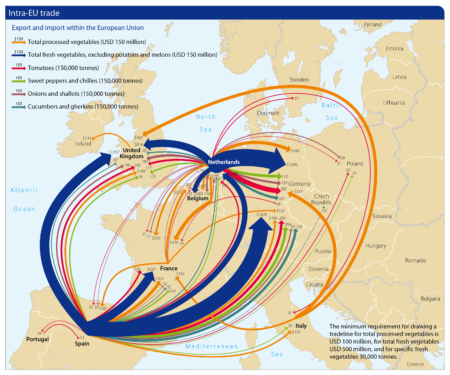- Is local biodiversity declining or not? A summary of the debate over analysis of species richness time trends. Better data needed.
- How endogenous plant pararetroviruses shed light on Musa evolution. Some banana plants have B genomes which are non-infective for potentially nasty viral integrants, making them good parents in breeding programmes.
- Late Holocene forest contraction and fragmentation in central Africa. From one horse’s mouth: “…this fragmentation 2500 years ago allowed the migration of the Bantu through the forests, who were able to exploit pioneering trees, such as energy rich oil palms which had colonized the gaps created, as well as being able to cultivate for the first times cereals in this newly created agricultural zone, notably pearl millet.”
- Cryobiotechnology of apple (Malus spp.): development, progress and future prospects. “…one of the most extensively studied plant genera with respect to cryopreservation.”
- Sustaining the Future of Plant Breeding: The Critical Role of the USDA-ARS National Plant Germplasm System. The next level: gap filling, more phenotyping and genotyping, better info systems, more pre-breeding, improved training for using PGR in breeding programs, expanded outreach. Could say the same about the rest of the world too.
- Role of Viral Diagnostics in Quarantine for Plant Genetic Resources and Preparedness. Calls for India to put in place a “National Plant Pests Diagnostic and Certification Network.” Maybe should be added to above.
- Threatened Goat Breeds from the Tropics: The Impact of Crossbreeding with Foreign Goats. You need to be careful with it, Brazilians say.
- Importance of native animal genetic resources. Turks too.
- Editorial: Harvesting plant and microbial biodiversity for sustainably enhanced food security. A whole Research Topic, no less. No animals though…
- Genotypic variability enhances the reproducibility of an ecological study. Because it buffers the effects of “environmental” differences in laboratory studies.
- Unlocking new alleles for leaf rust resistance in the Vavilov wheat collection. 13 new loci, maybe.
- Leaf Doctor: A New Portable Application for Quantifying Plant Disease Severity. Something to test the above with.
- Household Determinants of the Adoption of Improved Cassava Varieties using DNA Fingerprinting to Identify Varieties in Farmer Fields: A Case Study in Colombia. 434 samples from 217 farmers reveals 120 varieties, 9 of which were improved; farmers overestimate their use of new varieties, but in general those with more dependents, more land, and more access to extension have more improved varieties.
Genebank users grinning globally
USDA just announced an update to their instance of GRIN-Global, the genebank data management system, where you can explore the holdings of the U.S. National Plant Germplasm System at your leisure. From there the data finds its way to Genesys, where you can compare US holdings with those of other contributing genebanks. Perhaps the most significant change is the resurrection of the Crop Wild Relatives search page, a monumental resource.
ITPGRFA Benefit-Sharing Fund sharing funds again
From an FAO press release:
The Call for Proposals under the fourth cycle of projects to be funded through the Benefit-sharing Fund of the FAO International Treaty on Plant Genetic Resources for Food and Agriculture is now open. All developing countries that are Contracting Parties to the International Treaty are eligible to apply for funding under the Benefit-sharing Fund (BSF), which will invest at least USD 5 million in projects over the next four years.
All the details are on the Treaty website. Good luck, everyone!
Jobs available
Fancy blasting plants with mutation-inducing atomic rays? Good news just in from our friend Norman Warthmann, who recently joined the Plant Breeding and Genetics Laboratory of the FAO/IAEA joint Division in Vienna, Austria. They have two fairly high-level job openings. I can’t actually find the vacancy notices on the site, but I’m sure if you email Norman, he’ll send them to you.
Good luck.
LATER: One of the jobs is as a plant breeder.
Veggiexit
Gosh, I hope the Brits make a trade deal on vegetables.
